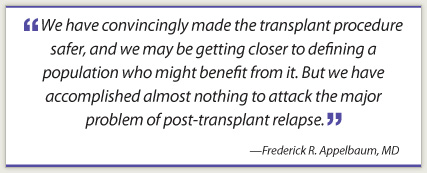 More than 3 decades ago, the first trials of autologous hematopoietic cell transplantation as consolidation therapy for acute myeloid leukemia (AML) in first remission were conducted. The initial results were inconclusive; most patients survived the procedure, but post-transplant relapse was common and overall survival did not appear to be markedly different from that which could be achieved with chemotherapy alone. Unable to make a more definitive statement, we reached the not particularly insightful but obviously true conclusion that “to improve results, both transplant-related deaths and post-transplant relapse must be decreased.”1
More than 3 decades ago, the first trials of autologous hematopoietic cell transplantation as consolidation therapy for acute myeloid leukemia (AML) in first remission were conducted. The initial results were inconclusive; most patients survived the procedure, but post-transplant relapse was common and overall survival did not appear to be markedly different from that which could be achieved with chemotherapy alone. Unable to make a more definitive statement, we reached the not particularly insightful but obviously true conclusion that “to improve results, both transplant-related deaths and post-transplant relapse must be decreased.”1
Progress and Challenges
Over the ensuing 30 years, multiple studies have been conducted attempting to achieve these goals. Those aimed at reducing transplant-related deaths have had some success. The combination of busulfan (Busulfex, Myleran) and cyclophosphamide has largely replaced high-dose total body irradiation–based regimens with a decrease in regimen-related toxicity. Modern antimicrobials provide better protection against opportunistic infections. And the use of peripheral blood stem cells as opposed to marrow results in faster, more reliable engraftment. With these changes, the nonrelapse mortality associated with autologous hematopoietic cell transplantation for AML is now less than 5% in most series.2
In contrast, there has not been any obvious success in efforts to reduce post-transplant relapse rates. More aggressive chemotherapy prior to stem cell harvest, purging of the stem cell product using antibodies or chemotherapies, tandem rather than single transplants, and post-transplant immunotherapies have all been explored, but there is as yet no conclusive evidence that any of these approaches has been successful in reducing relapse rates.
Unfortunately, some of the approaches that make the procedure safer may, in fact, increase relapse rates. In particular, Gorin et al, after analyzing 2,165 patients who received autografts for AML in first remission, concluded that the relapse rates were significantly higher with peripheral blood as opposed to marrow, resulting in inferior leukemia-free survival.3 They further found that those patients infused with the highest CD34-positive cell doses, although engrafting faster, had the highest relapse rates of all.4
Role in Survival
Since the initial trials demonstrating the feasibility of the approach, multiple prospective studies have been performed attempting to evaluate the actual role of autologous hematopoietic cell transplantation as therapy for AML in first complete remission. In the decade between 1989 and 1998, six prospective randomized trials were performed in which patients with AML in first remission were randomized to receive either autologous hematopoietic cell transplantation with bone marrow as the source of stem cells or further chemotherapy. A meta-analysis of these trials showed that autologous transplant was associated with better disease-free survival but similar overall survival.5
In the decade since the completion of these trials, at least three similar studies have been conducted using peripheral blood rather than marrow as the stem cell source. The general conclusions of these more recent studies were similar to those using marrow, and a meta-analysis of all trials comparing autologous hematopoietic cell transplantation to chemotherapy published through 2010 concluded that autologous transplant is associated with improved disease-free survival but no benefit in overall survival.6 Based on these outcomes, an evidence-based review of the field conducted by the American Society for Blood and Marrow Transplantation concluded that “there is no significant advantage for autologous hematopoietic cell transplantation over chemotherapy.”7
New Findings
Two recent publications yet again raise the question of a possible role of autologous hematopoietic cell transplantation as consolidation therapy for AML in first remission. Vellenga et al for the Dutch, Belgian, and Swiss groups has published the results of their AML-29 and AML-42 trials, in which patients without donors were randomly assigned to either autologous hematopoietic cell transplantation or chemotherapy.2 They show a relatively low transplant-related mortality with autologous transplantation (4%) and better relapse-free survival at 5 years (38% vs 29%). However, like other studies of autologous hematopoietic cell transplantation, overall survival at 5 years was not superior to that seen with chemotherapy (44% vs 41%) because of more opportunities for salvage therapy among patients relapsing on the chemotherapy arm (see sidebar).
 More recently, Pfirrmann et al for the German Study Alliance Leukaemia, using data from their AML96 and AML 2003 trials, developed a postremission treatment score capable of predicting the risk of relapse after attainment of complete remission.8 Using age, percent of CD34-positive blasts, FLT3-ITD allelic ratio, cytogenetic risk, and de novo vs secondary AML, they were able to segregate patients into favorable-, intermediate-, and unfavorable-risk groups. They then analyzed the overall survival in each group according to treatment. In all three risk groups, those receiving chemotherapy did the worst. Somewhat surprisingly, allogeneic transplantation led to the best outcome in those in the favorable and unfavorable risk groups, but for those in the intermediate-risk group, autologous transplant was associated with the best overall outcome. Confirmation of these results by other groups should be encouraged.
More recently, Pfirrmann et al for the German Study Alliance Leukaemia, using data from their AML96 and AML 2003 trials, developed a postremission treatment score capable of predicting the risk of relapse after attainment of complete remission.8 Using age, percent of CD34-positive blasts, FLT3-ITD allelic ratio, cytogenetic risk, and de novo vs secondary AML, they were able to segregate patients into favorable-, intermediate-, and unfavorable-risk groups. They then analyzed the overall survival in each group according to treatment. In all three risk groups, those receiving chemotherapy did the worst. Somewhat surprisingly, allogeneic transplantation led to the best outcome in those in the favorable and unfavorable risk groups, but for those in the intermediate-risk group, autologous transplant was associated with the best overall outcome. Confirmation of these results by other groups should be encouraged.
It should be possible to further improve on the approach to patient selection taken by Pfirrmann. Their analysis did not include recently identified mutational markers of disease-risk, such as IDH1 and 2, DNMT3A, and ASXL1. Nor did they incorporate advances in detection of minimal residual disease, such as modern multiparametric flow cytometry, which we have found to be a very sensitive predictor of post-transplant relapse in the allogeneic setting.9
Questions Remain
So after 3 decades, what do we as a community have to show for our work? We have convincingly made the transplant procedure safer, and we may be getting closer to defining a population who might benefit from it. But we have accomplished almost nothing to attack the major problem of post-transplant relapse.
Perhaps that is not surprising given that we really don’t know why the procedure works in the first place. Do we really think that if there are leukemic stem cells in the patient, they aren’t in the stem cell inoculum? Are they less able than normal stem cells to survive cryopreservation or to re-engraft? Is there a transient autologous graft-vs-tumor reaction during the early engraftment period? Until we understand more about why the procedure works, we’ll have to be pretty lucky to make it much better. ■
Disclosure: Dr. Applebaum reported no conflicts of interest.
Dr. Appelbaum is Director of the Clinical Research Division, Fred Hutchinson Cancer Research Center, and Professor, Medical Oncology Division, University of Washington School of Medicine, Seattle.
References
1. Stewart P, Buckner CD, Bensinger W, et al: Autologous marrow transplantation in patients with acute nonlymphocytic leukemia in first remission. Exp Hematol 13:267-272, 1985.
2. Vellenga E, van Putten W, Ossenkoppele GJ, et al: Autologous peripheral blood stem cell transplantation for acute myeloid leukemia. Blood 118:6037-6042, 2011.
3. Gorin NC, Labopin M, Blaise D, et al: Higher incidence of relapse with peripheral blood rather than marrow as a source of stem cells in adults with acute myelocytic leukemia autografted during the first remission. J Clin Oncol 27:3987-3993, 2009.
4. Gorin NC, Labopin M, Reiffers J, et al: Higher incidence of relapse in patients with acute myelocytic leukemia infused with higher doses of CD34+ cells from leukapheresis products autografted during the first remission. Blood 116:3157-3162, 2010.
5. Nathan PC, Sung L, Crump M, et al: Consolidation therapy with autologous bone marrow transplantation in adults with acute myeloid leukemia. J Natl Cancer Inst 96:38-45, 2004.
6. Wang J, Ouyang J, Zhou R, et al: Autologous hematopoietic stem cell transplantation for acute myeloid leukemia in first complete remission. Acta Haematol 124:61-71, 2010.
7. Oliansky DM, Appelbaum F, Cassileth PA, et al: The role of cytotoxic therapy with hematopoietic stem cell transplantation in the therapy of acute myelogenous leukemia in adults. Biol Blood Marrow Transplant 14:137-180, 2008.
8. Pfirrmann M, Ehninger G, Thiede C, et al: Prediction of post-remission survival in acute myeloid leukaemia. Lancet Oncol 13:207-214, 2012.
9. Walter RB, Gooley TA, Wood BL, et al: Impact of pretransplantation minimal residual disease, as detected by multiparametric flow cytometry, on outcome of myeloablative hematopoietic cell transplantation for acute myeloid leukemia. J Clin Oncol 29:1190-1197, 2011.

